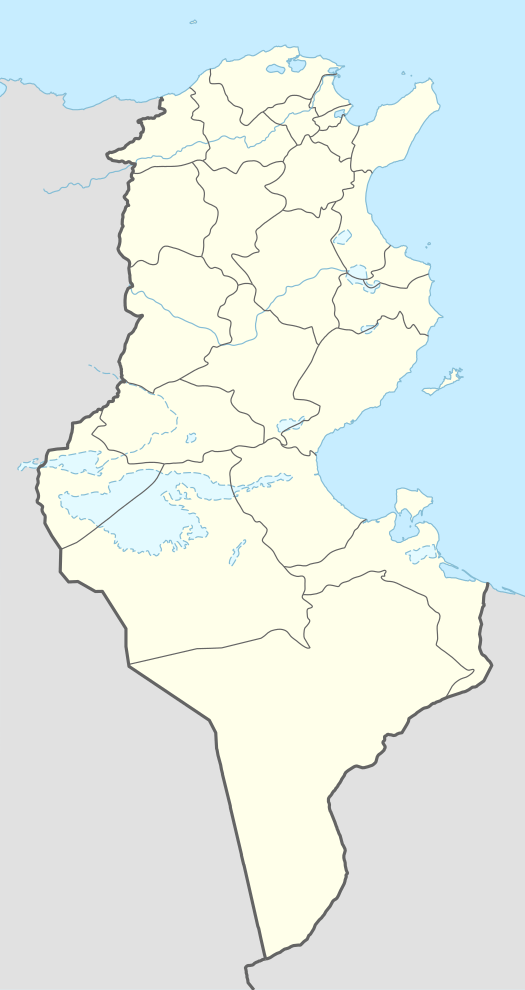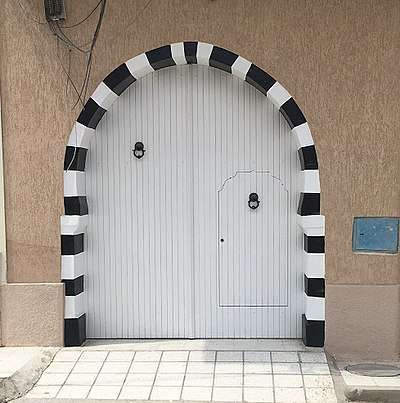M'saken
M'saken (Arabic: مساكن Msākan; also spelled Masakin, Msaken) is a town in north-eastern Tunisia, close to Sousse.
M'saken مساكن | |
|---|---|
Monument in M'saken city center 2012 | |
 M'saken Location in Tunisia | |
| Coordinates: 35°44′0″N 10°35′0″E | |
| Country | |
| Governorate | Sousse Governorate |
| Regions of Tunisia | Sahel |
| Government | |
| • Mayor | Mohamed Alaya |
| • Vice Mayor | Zoubeir Graïet |
| Elevation | 469.16 ft (143 m) |
| Population (2014) | |
| • City | 72,953 |
| • Metro | 97,225 |
| Time zone | UTC1 (CET) |
| Area code(s) | 216 |
Etymology
The origin of the word comes from "Msaken" masken (plural masken) meaning "habitat", "house" or "dwelling". This refers to "Houses of honorable people" (Masken el achraf) due to the distinguished lineage of its first inhabitants.
Administration
The town is the administrative center of a "delegation" (district) of the same name, which at the 2014 Census had a population of 97,225.
Municipality
M'saken municipality was found in 19/02/1921.
The actual municipal council was elected in the Local elections of Tunisia in May 9th,2018. Its composition by party is as follows:
| Party | Seats |
|---|---|
| Ennahdha | 12 |
| Nidaa Tounes | 4 |
| Courant démocrate | 3 |
| Chemin du Progrès | 2 |
| Front populaire | 2 |
| Union civile | 2 |
Villages and towns of Delegation
The following villages and Towns are part of M'saken delegation [1] M'saken region Map
| Village/Town | Distance to M'saken(Km) | Population (2014) | Municipality |
|---|---|---|---|
| Borjine | 7 | 3,966 | M'saken |
| Beni Rabiâa | 6 | 3,528 | M'saken |
| Beni Kalthoum | 2 | 2,453 | M'saken |
| Knaies | 8 | 4,780 | M'saken |
| Frada | 26 | 1,434 | M'saken |
| Moureddine | 7 | 3,614 | M'saken |
| Messaadine | 2 | 12,930 | Messaadine |
Personalities from M'saken
- Habib Chatti, Politician, Diplomat
- Zied Ladhari, Politician.
- Zoubeir Baya, Football player
- Saïf Ghezal, Football player.
- Habib Essid, Prime Minister of Tunisia 6 February 2015 to 27 August 2016. Born in Sousse, his family is originally from M'saken.
- Hamed El Karoui, Prime Minister of Tunisia from 27 September 1989 to 17 November 1999. Born in Sousse, his family, by the name of Wada, is originally from M'saken.
- Ridha Layouni: President of Association of National Olympic Academies of Africa (AANOA) and Former Tunisian National Olympic Committee.
- Brahim Babaï, Producer.
- Jalila Hafsia, Journalist, Writer.
- Chedly Anouar, Musician.
- Mohamed Bellalouna, Politician.
Traditional doors
Traditional houses of M'saken have typical traditional doors which are also found in the neighbour villages and towns (Zaouiet Sousse, Ouerdanine, Beni Kalthoum, fr:Borjine, Moureddine ...). The door can be double or with single leaf, and has always a small leaf inside called khoukha (literally =pear). ar:باب بالخوخة

.jpg)

History
According to local tradition, M'saken was founded by a group of descendants of Husayn Ibn Ali, grandson of the prophet Muhammad. They had come to North Africa escaping from the Abbassid rulers of Baghdad, who had been engaged in a cruel fight against Sharifians (descendants of Husayn and his brother Hassan).
They founded a Sharifian Emirate in near present-day Tiaret in west-central Algeria. After three generations, following the fall of this Emirate, some of their descendants lived in eastern Morocco near Oujda for some time, before moving to Kairouan in Tunisia. After some decades, they founded the town of M'saken at the time of the Hafsid dynasty which was based in Tunis.
Their town was originally called 'Kousour al Ashraf' (which means "Sharif's houses"), then 'Masakin al Ashraf' (which has the same meaning), and finally Masakin - or 'Msaken' as it is pronounced and spelled in North Africa. The town centre was built around the Jamma al Awsat (which means the central mosque) and was composed of five ksars (great houses).
Historic monuments
The Awsat Mosque of M'saken is among the oldest known monuments of M'saken city. It was founded around the year 1360.
Soufism
M'saken is known to be a religious city. It included the Madrasa of Sidi Ali ben Khalifa and over the centuries has been home to a number of Sufi figures:
- Sheikh Mohamed Gazzah
- Sheikh Ladharai
- Sidi Omar Shatti
- Sidi Ali Ben Khalifa
Statistics
- Population: 125,694 inhabitants (Whole delegation 2018 census)
- Altitude: 112 m
- Number of hospitals: (private and public) 3
Traditional dresses
Traditional dresses of M'saken as typical of North Africa and more specifically of the Tunisian Sahel region.
The Melya, traditional dress of women in North Africa, was used in M'saken but today it is no longer used.
In Tunisia, each village or region uses a specific color for its women Houli (Melya). According to old people it had the color gold for M'saken women.
M'saken dialect
M'saken people speak the Msakni dialect, which is branch of the Sahli dialect, specific to the Sahel,_Tunisia region , and which is a Pre-Hilalian_Arabic_dialect and a citadin pre hilalian language The most characteristic word being the pronoun of the first person singular pronounced 'eni' in the Sahel instead of 'ena': In M'saken it is said 'yeni' by replacing the vowel 'e' by 'y' M'saken dialect is also recognisable by the strong vowel 'i' at the end of many words (nouns and verbs ) which are pronounced at the end with a soft 'i' in the rest of the Sahel and as 'e' or 'a' in the rest of Tunisia and North Africa.
- Examples:
- He went: Mshi (M'saken), Mshei (rest of Sahel), Mshe (Tunis), Msha (Cetral and west Algeria)
- He ate : Kli (M'saken), Klei (rest ofSahel), Kle(Tunis), Kla (Central and west Algeria)
- Water: Mi (M'saken), Mei (rest of Sahel), Me(Tunis), Ma (Central and West Algeria)
- Here: Hni (M'saken), Hnei(Rest of Sahel), Hne or Houni(Tunis),Hna(Central and West Algeria)
Migrations
M'saken has a large population living in foreign countries, mainly in France and more particularly in the Côte d'Azur region, in Nice and neighbouring areas. According to some sources, 40% of the population of M'saken lives outside Tunisia. The town's population increases very significantly in July and August every year following the return of migrants to their hometown for the holidays.
The climate
Köppen-Geiger climate classification system classifies M'saken climate as hot semi-arid (BSh)[2] bordering with hot-summer Mediterranean (Csa).
It is considered to be a local steppe climate.
There is little rainfall throughout the year.
The average annual temperature is 18.3 °C in M'Saken.
In a year, the average rainfall is 347 mm.
Sport
M'saken has many sport teams:
- Football / Handball : Croissant Sportif de M'saken founded in 1945.
- Rugby : Avenir sportif de M'saken founded in 1991.
See also
References
- Population
- "Climate: M'saken - Climate graph, Temperature graph, Climate table". Climate-Data.org. Retrieved 16 September 2018.
External links
- Commune de M'saken
- M'saken Climate
- Msakenian language (fr)
